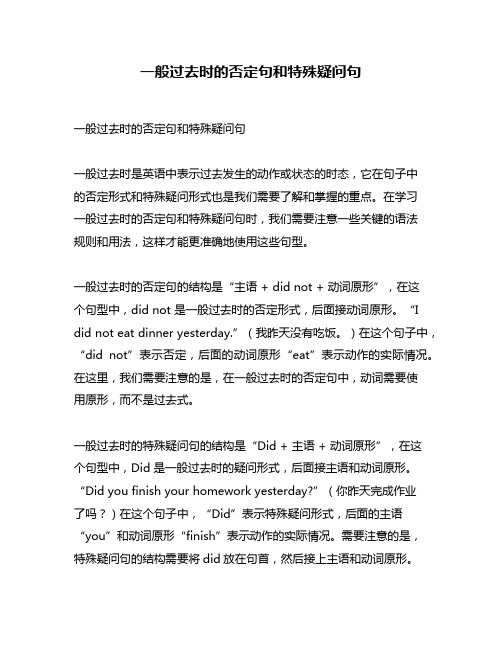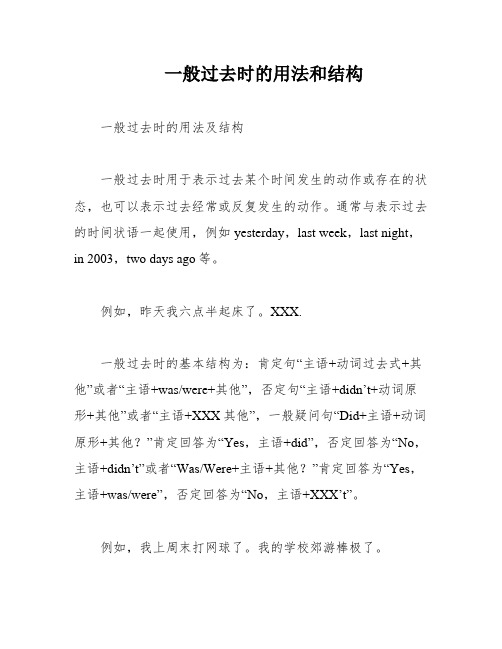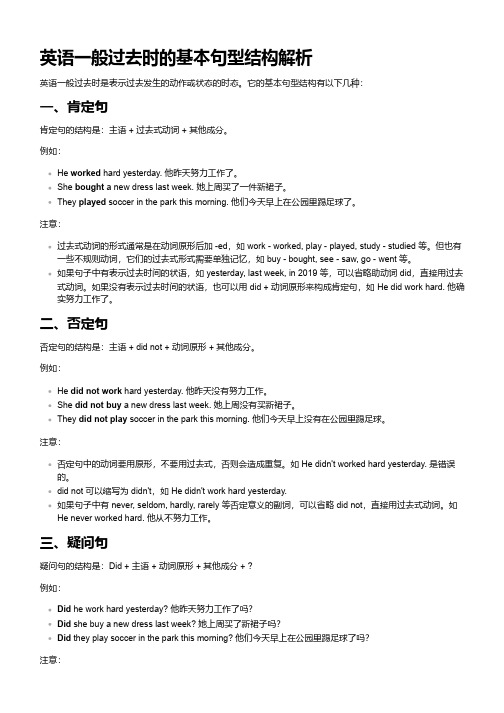一般过去式的否定句
一般过去时的否定句和特殊疑问句

一般过去时的否定句和特殊疑问句一般过去时的否定句和特殊疑问句一般过去时是英语中表示过去发生的动作或状态的时态,它在句子中的否定形式和特殊疑问形式也是我们需要了解和掌握的重点。
在学习一般过去时的否定句和特殊疑问句时,我们需要注意一些关键的语法规则和用法,这样才能更准确地使用这些句型。
一般过去时的否定句的结构是“主语 + did not + 动词原形”,在这个句型中,did not 是一般过去时的否定形式,后面接动词原形。
“I did not eat dinner yesterday.”(我昨天没有吃饭。
)在这个句子中,“did not”表示否定,后面的动词原形“eat”表示动作的实际情况。
在这里,我们需要注意的是,在一般过去时的否定句中,动词需要使用原形,而不是过去式。
一般过去时的特殊疑问句的结构是“Did + 主语 + 动词原形”,在这个句型中,Did 是一般过去时的疑问形式,后面接主语和动词原形。
“Did you finish your homework yesterday?”(你昨天完成作业了吗?)在这个句子中,“Did”表示特殊疑问形式,后面的主语“you”和动词原形“finish”表示动作的实际情况。
需要注意的是,特殊疑问句的结构需要将did放在句首,然后接上主语和动词原形。
总结一般过去时的否定句和特殊疑问句的结构和用法,我们可以得出以下几点要点:1. 一般过去时的否定句结构为“主语 + did not + 动词原形”,动词需要使用原形;2. 一般过去时的特殊疑问句结构为“Did + 主语 + 动词原形”,动词同样使用原形;3. 在否定句和特殊疑问句中,did not 和 did 的使用对于句子的否定和疑问形式至关重要。
从简单的了解一般过去时的肯定句句型开始,深入探究否定句和特殊疑问句,可以帮助我们更全面地掌握这个时态的用法。
通过实际的例句和练习,我们将能更加熟练地运用这些句型,从而提高我们的英语表达能力。
一般过去时结构句型

一般过去时结构句型一般过去时(Simple Past Tense)是英语中用来表示过去已经发生的动作、事实或者状态的一种时态。
在一般过去时中,我们使用一般过去时的结构来描述过去的情况、事件或者动作。
一般过去时的结构包括肯定句、否定句和疑问句三种形式。
一、肯定句结构:1. 对于大多数动词,一般过去时的肯定句结构是主语 + 动词的过去式 + 其他成分。
例如: I studied English last night. 我昨晚学了英语。
She went to the park with her friends. 她和朋友们一起去了公园。
2. 如果动词是以辅音字母加“y”结尾的,一般过去时的肯定句结构是主语 + 动词的过去式 + 其他成分。
例如: He carried the bags for us. 他为我们提了包。
They played football in the park. 他们在公园踢足球。
3. 如果动词是以“e”结尾的,一般过去时的肯定句结构是主语 + 动词的过去式 + 其他成分。
例如: I danced at the party last night. 昨晚我在派对上跳舞。
She smiled when she saw the gift. 当她看到礼物时,她笑了。
二、否定句结构:一般过去时的否定句结构是主语 + did not (didn’t) + 动词原形 + 其他成分。
例如:I didn’t go to the cinema last weekend. 上个周末我没有去电影院。
They didn’t eat lunch at school yesterday. 昨天他们没在学校吃午饭。
三、疑问句结构:一般过去时的疑问句结构是 Did + 主语 + 动词原形+ 其他成分?例如: Did you watch the movie last night? 昨晚你看了电影吗?Did they visit their grandparents during the holidays? 假期期间他们去看望了爷爷奶奶吗?在使用一般过去时的时候,还需要掌握一些特殊情况下的用法和变化规则。
一般过去时的用法和结构

一般过去时的用法和结构一般过去时的用法及结构一般过去时用于表示过去某个时间发生的动作或存在的状态,也可以表示过去经常或反复发生的动作。
通常与表示过去的时间状语一起使用,例如yesterday,last week,last night,in 2003,two days ago等。
例如,昨天我六点半起床了。
XXX.一般过去时的基本结构为:肯定句“主语+动词过去式+其他”或者“主语+was/were+其他”,否定句“主语+didn’t+动词原形+其他”或者“主语+XXX其他”,一般疑问句“Did+主语+动词原形+其他?”肯定回答为“Yes,主语+did”,否定回答为“No,主语+didn’t”或者“Was/Were+主语+其他?”肯定回答为“Yes,主语+was/were”,否定回答为“No,主语+XXX’t”。
例如,我上周末打网球了。
我的学校郊游棒极了。
这个女孩昨天下午没玩电子游戏。
上星期五老XXX不高兴。
特殊疑问句的结构为:特殊疑问词+一般疑问句(顺序)?例如,XXX上周末干什么了?他去看了他的祖父母。
你昨天在哪儿?我在家里。
为了帮助记忆实义动词一般过去时的用法和结构,我们可以使用以下歌诀:“动词一般过去时,表示过去发生事。
谓语动词过去式,过去时间作标志。
否定形式很简单,主语之后加didn't。
谓语动词要还原。
疑问构成有规则,主语前面加did。
”过去式的构成有两种方式:be动词和实义动词。
系动词be的过去式有两种形式:was和were。
其中,was是am和is的过去式,were是are的过去式。
实义动词过去式的构成有以下几种规则:1.一般在动词末尾加-ed,例如walk→walked,play→played;2.以不发音e结尾的动词末尾只加-d,例如love→loved,decide→decided;3.以“辅音字母+y”结尾的动词,先将y变为i,再加-ed,例如study→studied,carry→carried;4.末尾只有一个辅音字母的重读闭音节,先双写该辅音字母,再加-ed,→ped,plan→planned。
一般过去时的否定句和疑问句

一般过去时的否定句和疑问句一般过去时的否定句(Negative Sentences in Simple Past Tense)一般过去时的否定句用于描述过去发生的事情中的否定情况。
构成一般过去时的否定句需要在动词前加上助动词 "did not" 或"didn't",并将动词本身保持原形。
以下是构成一般过去时的否定句的示例:1. 主语 + did not/didn't + 动词原形 + 其他成分- 例如:She did not/didn't go to the party last night.2. 主语 + did not/didn't + 动词原形 + 否定词 + 其他成分- 例如:I didn't see anyone in the park yesterday.需要注意的是,当动词本身为be动词时,不需要再使用助动词 "did"。
直接在be动词前加上 "not" 即可构成否定句。
例如:一般过去时的疑问句(Interrogative Sentences in Simple Past Tense)一般过去时的疑问句用于询问过去发生的事情。
构成一般过去时的疑问句需要将助动词 "did" 放在主语之前,并将动词本身保持原形。
以下是构成一般过去时的疑问句的示例:1. Did + 主语 + 动词原形 + 其他成分?- 例如:Did you study for the test yesterday?2. Did + 主语 + 动词原形 + 否定词 + 其他成分?- 例如:Did she not/didn't watch the movie last night?当动词本身为be动词时,同样需要将助动词 "did" 放在主语之前,形成疑问句。
六年级英语一般过去时否定句单选题40题

六年级英语一般过去时否定句单选题40题1. Tom _________ play football yesterday.A. didn'tB. don'tC. doesn'tD. isn't答案:A。
本题考查一般过去时的否定形式。
一般过去时的否定句结构是“主语+ didn't + 动词原形”,A 选项“didn't”符合;B 选项“don't”用于一般现在时;C 选项“doesn't”用于一般现在时第三人称单数;D 选项“isn't”是be 动词的否定形式,不符合本题要求。
2. They _________ go to the zoo last weekend.A. didn'tB. don'tC. weren'tD. aren't答案:A。
此题考查一般过去时的否定表达。
一般过去时否定句用“didn't + 动词原形”,A 选项“didn't”符合,后面接动词原形“go”;B 选项“don't”用于一般现在时;C 选项“weren't”是be 动词的过去式否定形式,后面不能接动词原形;D 选项“aren't”是be 动词的现在时否定形式。
3. My mother _________ cook dinner yesterday.A. didn'tB. doesn'tC. don'tD. wasn't答案:A。
本题主要考查一般过去时的否定句。
一般过去时否定用“didn't + 动词原形”,A 选项“didn't”正确,后接动词原形“cook”;B 选项“doesn't”用于一般现在时第三人称单数;C 选项“don't”用于一般现在时;D 选项“wasn't”是be 动词的过去式否定形式,后面不能接动词原形。
一般过去时的否定句和特殊疑问句

一般过去时的否定句和特殊疑问句
过去时的否定句:
一般过去时表示过去发生的动作或状态。
在构成否定句时,在动词前加上“did not”,也可缩写为“didn't”。
以下是一些例句:
1. I did not go to work yesterday.(我昨天没有去上班。
)
2. They did not study for the test.(他们没有为考试学习。
)
3. She didn't like the movie.(她不喜欢这部电影。
)
4. We did not visit the museum.(我们没有参观博物馆。
)
5. He didn't play basketball last night.(他昨晚没有打篮球。
)
特殊疑问句:
特殊疑问句用于询问特殊信息,通常使用疑问词开头。
以下是一些例句:
1. Where did you go on your vacation?(你假期去哪里了?)
2. When did they arrive at the airport?(他们什么时候到达机场的?)
3. Why didn't she join us for dinner?(她为什么没和我们一起吃晚餐?)
4. How did they solve the problem?(他们是如何解决这个问题的?)
5. What did you buy at the grocery store?(你在杂货店买了什么?)
希望以上的信息能帮到您。
若有其他问题,请随时提问。
四年级下册英语一般过去式句子改为否定句

四年级下册英语一般过去式句子改为否定句1、was/were+not。
2、在行为动词前加didn't,同时还原行为动词。
例句:I didn't know you like coffee.——我不知道你喜欢咖啡。
肯定句变为否定句:1、当句中含有情态动词或助动词could,would,should等时,可直接在其后面加not构成否定句。
例如:I could get you a concert ticket. → I could not / couldn't get you a concert ticket.2、当句中含有系动词was,were 时,可直接在其后加not构成否定句。
例如:I was on the Internet when you called me. → I was not / wasn't on the Internet when you called me.3、当句中谓语是除情态动词、助动词、系动词was,were以外的动词时,在该动词之前加did not / didn't,动词还原,构成否定句。
例如:The famous singer sang some Chinese songs. → The famous singer did not / didn't sing any Chinese songs.扩展资料:记忆口诀一般过去时并不难,过去动作、状态记心间。
动词要用过去式,时间状语句末站。
否定句很简单,didn't 站在动原前,其它部分不要变。
一般疑问句也好变,did放在句子前,主语、动原、其它部分依次站立。
特殊疑问句也简单,疑问词加一般疑问句记心间。
一般过去时表示过去某个时间或某一段时间内发生的动作或存在的状态,常和过去的时间状语连用。
小升初英语一般过去时否定句练习题50题

小升初英语一般过去时否定句练习题50题1.I didn't go to school yesterday.A.I not go to school yesterday.B.I no go to school yesterday.C.I didn't went to school yesterday.答案:I didn't go to school yesterday. 本题考查一般过去时否定句的正确构成。
一般过去时否定句的构成是主语+didn't+动词原形。
选项A 和B 的表达错误,不符合语法规则。
选项C 中didn't 后面应该用动词原形go,而不是went。
2.She didn't eat an apple last night.A.She no eat an apple last night.B.She not eat an apple last night.C.She didn't ate an apple last night.答案:She didn't eat an apple last night. 一般过去时否定句结构为didn't+动词原形。
选项A 和B 错误,不符合语法。
选项C 中didn't 后应用动词原形eat,而不是ate。
3.We didn't play football on Sunday.A.We no play football on Sunday.B.We not play football on Sunday.C.We didn't played football on Sunday.答案:We didn't play football on Sunday. 一般过去时否定句是didn't+动词原形。
选项A 和B 错误,不符合语法要求。
选项C 中didn't 后应接动词原形play,而非played。
一般过去时的基本句型结构

英语一般过去时的基本句型结构解析英语一般过去时是表示过去发生的动作或状态的时态。
它的基本句型结构有以下几种:一、肯定句肯定句的结构是:主语 + 过去式动词 + 其他成分。
例如:He worked hard yesterday. 他昨天努力工作了。
She bought a new dress last week. 她上周买了一件新裙子。
They played soccer in the park this morning. 他们今天早上在公园里踢足球了。
注意:过去式动词的形式通常是在动词原形后加 -ed,如 work - worked, play - played, study - studied 等。
但也有一些不规则动词,它们的过去式形式需要单独记忆,如 buy - bought, see - saw, go - went 等。
如果句子中有表示过去时间的状语,如 yesterday, last week, in 2019 等,可以省略助动词 did,直接用过去式动词。
如果没有表示过去时间的状语,也可以用 did + 动词原形来构成肯定句,如 He did work hard. 他确实努力工作了。
二、否定句否定句的结构是:主语 + did not + 动词原形 + 其他成分。
例如:He did not work hard yesterday. 他昨天没有努力工作。
She did not buy a new dress last week. 她上周没有买新裙子。
They did not play soccer in the park this morning. 他们今天早上没有在公园里踢足球。
注意:否定句中的动词要用原形,不要用过去式,否则会造成重复。
如 He didn't worked hard yesterday. 是错误的。
did not 可以缩写为 didn't,如 He didn't work hard yesterday.如果句子中有 never, seldom, hardly, rarely 等否定意义的副词,可以省略 did not,直接用过去式动词。
小升初英语一般过去时否定句单选题50题

小升初英语一般过去时否定句单选题50题1. I ______ play football yesterday.A. didn'tB. don'tC. doesn'tD. wasn't答案:A。
本题考查一般过去时的否定形式。
一般过去时的否定句结构是“主语+ didn't + 动词原形”,A 选项“didn't”符合;B 选项“don't”是一般现在时的否定形式;C 选项“doesn't”是一般现在时第三人称单数的否定形式;D 选项“wasn't”是be 动词的否定形式,后接现在分词,不能接动词原形。
2. They ______ go to the zoo last weekend.A. didn'tB. don'tC. weren'tD. doesn't答案:A。
一般过去时的否定句用“didn't + 动词原形”,A 选项正确;B 选项“don't”是一般现在时否定形式;C 选项“weren't”后接现在分词,不能接动词原形;D 选项“doesn't”是一般现在时第三人称单数的否定形式。
3. She ______ do her homework last night.A. didn'tB. don'tC. doesn'tD. wasn't答案:A。
一般过去时的否定句结构为“主语+ didn't + 动词原形”,A 选项符合;B 选项“don't”用于一般现在时;C 选项“doesn't”用于一般现在时第三人称单数;D 选项“wasn't”后接现在分词,不符合要求。
4. We ______ have a party yesterday.A. didn'tB. don'tC. aren'tD. weren't答案:A。
小升初英语一般过去时否定句单选题50题

小升初英语一般过去时否定句单选题50题1.I ____ go to the park yesterday.A.didn'tB.don'tC.wasn'tD.am not答案:A。
本题考查一般过去时的否定句结构。
一般过去时的否定句是在动词前加didn't,后面动词用原形。
B 选项don't 用于一般现在时;C 选项wasn't 后面不能直接跟动词原形;D 选项am not 用于现在进行时或一般现在时。
2.She ____ watch TV last night.A.didn'tB.don'tC.wasn'tD.isn't答案:A。
一般过去时的否定句用didn't+动词原形。
B 选项don't 用于一般现在时;C 选项wasn't 后面不能直接跟动词原形watch;D 选项isn't 用于现在进行时或一般现在时。
3.We ____ play football on Sunday.A.didn'tB.don'tC.wasn't答案:A。
考查一般过去时的否定句。
didn't 后面加动词原形play。
B 选项don't 用于一般现在时;C 选项wasn't 后不能跟动词原形;D 选项aren't 用于现在进行时或一般现在时。
4.They ____ go swimming last week.A.didn'tB.don'tC.wasn'tD.aren't答案:A。
一般过去时的否定句结构为didn't+动词原形。
B 选项don't 用于一般现在时;C 选项wasn't 后面不能直接跟动词原形go;D 选项aren't 用于现在进行时或一般现在时。
5.He ____ read a book in the morning.A.didn'tB.don'tC.wasn'tD.isn't答案:A。
一般过去时的否定句形式

一般过去时的否定句形式一般过去时是英语语法中最基础的过去式,表示在过去某一个时间内发生的动作或状态。
它是英语学习中必须掌握的语法内容之一。
在英语中,否定句形式的构造与肯定句形式有所不同。
下面,本文将为大家介绍一般过去时的否定句形式及其构造。
一、构造与例句一般过去时的否定句由“did not +动词原形”构成。
“did”是过去式助动词的缩写形式,不同于肯定句中的“did”相连。
下面我将举例说明:1. 肯定句:I went to America last year.(我去年去过美国。
)2. 否定句:I did not go to America last year.(我去年没去过美国。
)注意:在一般过去时的否定句中,“did not”缩写为“didn't”,即:“I didn't go to America last year."二、规则在构造一般过去时的否定句时,需要注意如下几点:1. 动词原形不同于现在时态使用动词原形“go”,在过去时态的否定句中我们也需要使用动词原形“go”,而不是过去分词“gone”。
2. 句式结构在一般过去时态的否定句中,did后需加not(缩写为“didn't”),而肯定句则省略not。
3. 所有人称的动词所有人称的动词在否定句中无需加s/es。
4. 陈述式形式一般过去时的否定句形式为“S + did not + 动词原形”。
三、常用的否定句词组在构造一般过去时的否定句时,常用以下的否定句词组,例如:1. didn’t (did not) 未做2. wasn’t (was not) 不是3. didn’t have (did not have) 没有4. didn’t mean (did no t mean) 没有意思5. didn’t think (did not think) 没有想到6. didn’t realize (did not realize) 没有认识到7. didn’t want (did not want) 不想要四、实例分析以下是一个实例分析,表达了一个人曾经遇到改变他生命的事情,但是他错过了它。
一般过去时用法

一般过去时用法一般过去时是英语中最常用的过去时态之一,用于描述过去发生的动作、事件或状态。
本文将介绍一般过去时的用法、时态转换、标志词及常见注意事项。
一、一般过去时的用法一般过去时用于以下情况:1. 过去发生的具体动作或事件:- We went to the beach last summer.(我们去年夏天去了海滩。
)- He cooked dinner yesterday.(他昨天做了晚餐。
)2. 过去的习惯或经常性动作:- She always walked to school when she was young.(她小时候总是步行去学校。
)- We used to play basketball every Saturday.(我们过去每个星期六都会打篮球。
)3. 对现在具有影响的过去经历或经验:- I learned how to swim when I was a child, and now I love swimming.(我小时候学会游泳了,现在我非常喜欢游泳。
)- They lived abroad for five years and now they can speak fluent English.(他们在国外生活了五年,现在能够说一口流利的英语。
)二、时态转换1. 肯定句:一般过去时的肯定句结构为:主语 + 动词过去式(或助动词did + 动词原形)+ 其他。
- I studied Chinese for three years.(我学了三年中文。
)- She played tennis with her friends yesterday.(她昨天和朋友们打网球。
)2. 否定句:一般过去时的否定句结构为:主语 + did not (didn't) + 动词原形 +其他。
- We didn't go to the party last night.(我们昨晚没有去参加派对。
一般过去时的句子

一般过去时的句子一般过去时是英语中最基本的时态之一,用来描述过去发生的事情、习惯或状态。
在一般过去时的句子中,动词通常要加上-ed 结尾,但也有一些不规则动词需要特别记忆。
下面我们来详细了解一般过去时的句子结构和用法。
一般过去时的肯定句结构是,主语 + 动词过去式 + 其他。
例如:I watched a movie yesterday.(昨天我看了一部电影。
)。
She played basketball last week.(她上周打篮球。
)。
在一般过去时的句子中,动词过去式的变化规则是:一般情况下,在动词原形后加-ed。
例如,watched, played。
以不发音的e结尾的动词,只加-d。
例如,liked, danced。
以辅音字母+y结尾的动词,变y为i再加-ed。
例如,studied, tried。
另外,一般过去时也有一些不规则动词,它们的过去式需要特别记忆,比如:go的过去式是went。
eat的过去式是ate。
have的过去式是had。
一般过去时的否定句结构是,主语 + did not + 动词原形 +其他。
例如:I did not watch a movie yesterday.(昨天我没有看电影。
)。
She did not play basketball last week.(她上周没有打篮球。
)。
一般过去时的疑问句结构是,Did + 主语 + 动词原形 + 其他?例如:Did you watch a movie yesterday?(昨天你看了电影吗?)。
Did she play basketball last week?(她上周打篮球了吗?)。
在一般过去时的句子中,我们还需要注意一些时间状语的使用,比如yesterday(昨天)、last week(上周)、two days ago(两天前)等,它们可以帮助我们更清楚地表达动作发生的时间。
另外,一般过去时也可以用来描述过去的习惯或状态,比如:She used to play the piano when she was young.(她年轻的时候常常弹钢琴。
一般过去时的用法和结构

一般过去时的用法和结构一、肯定句的结构:主语+动词过去式(不规则动词根据变化规则)+其他成分例如:- I played basketball yesterday.(我昨天打篮球。
)- He cleaned his room last night.(他昨晚打扫了他的房间。
)二、否定句的结构:主语 + 助动词did(一般过去时助动词)+ not + 动词原形 + 其他成分例如:- I did not play basketball yesterday.(我昨天没有打篮球。
)- He did not clean his room last night.(他昨晚没有打扫他的房间。
)三、疑问句的结构:助动词did(一般过去时助动词)+ 主语 + 动词原形 + 其他成分例如:- Did you play basketball yesterday?(你昨天打篮球了吗?)- Did he clean his room last night?(他昨晚打扫了他的房间吗?)1.表示过去的经历或经验:- I lived in London for five years.(我在伦敦生活了五年。
)- She visited Paris last summer.(她去年夏天去了巴黎。
)2.表示过去的习惯或常常发生的动作:- He always drank coffee in the morning.(他过去常在早上喝咖啡。
)- We often played soccer on weekends.(我们过去经常在周末踢足球。
)3.表示过去的条件或假设:- If I had enough money, I would have bought a new car.(如果我有足够的钱,我就会买一辆新车。
)- I wish I knew the answer.(我希望我知道答案。
)4.表示过去的状态或属性:- The weather was sunny yesterday.(昨天天气晴朗。
(完整版)一般过去时的结构

(完整版)一般过去时的结构一般过去时的结构一般过去时的定义一般过去时是英语中用来表示过去发生的动作、情况和状态的时态。
它通常与过去的时间状语连用,用于叙述过去的事件。
一般过去时的结构一般过去时的结构包括主语、过去式的动词和其他补充成分。
- 主语:指代动作的执行者或经历者的名词或代词。
- 过去式的动词:表示动作在过去发生的词形。
- 其他补充成分:如时间状语和地点状语等,可以对句子进行补充说明。
一般过去时的肯定句结构一般过去时的肯定句结构为:主语 + 过去式的动词 + 其他补充成分例如:- I played soccer yesterday.(昨天我踢足球了。
)- She studied hard for the exam.(她为考试努力研究了。
)- They went to the beach last summer.(他们去年夏天去了海滩。
)一般过去时的否定句结构一般过去时的否定句结构为:主语 + didn't + 动词原形 + 其他补充成分例如:- I didn't watch TV last night.(我昨晚没看电视。
)- He didn't go to the party.(他没去参加派对。
)- We didn't visit the museum.(我们没参观博物馆。
)一般过去时的疑问句结构一般过去时的疑问句结构分为两种情况:一种是对动词进行疑问,一种是对其他补充成分进行疑问。
1. 对动词进行疑问的结构为:Did + 主语 + 动词原形 + 其他补充成分?例如:- Did you go to the party?(你去了派对吗?)- Did she study for the exam?(她为考试研究了吗?)- Did they play soccer yesterday?(他们昨天踢足球了吗?)2. 对其他补充成分进行疑问的结构为:Wh-词 + did + 主语 + 动词原形 + 其他补充成分?例如:- Where did you go last weekend?(你上个周末去了哪里?)- How did she get to the airport?(她怎么到达机场的?)- When did they start the project?(他们什么时候开始这个项目的?)以上是一般过去时的结构及相应的例句。
2020年中考英语知识点之一般过去时中肯定句变否定句的方法

2020年中考英语知识点之一般过去时中肯定句变否定句的
方法
一般过去时中肯定句变否定句的方法:
⑴当句中含有情态动词could/would/should等时,可直接在后面加上not,构成否定句。
(注意:could就是can的一般过去时)
例如:肯定I could get you a concert ticket .我能给你一张音乐会的票。
否定I could not/couldnt get you a concert ticket .
⑵含有be动词was/were的一般过去时:在be动词后面直接加not。
例如:I was late yesterday.-I wasnt late yesterday.我昨天没有迟到。
⑶当句中谓语动词是除了情态动词、助动词、be动词以外的实义动词,在该动词原形前加上did not,构成否定式。
例如:肯Jenny bought a T-shirt yesterday.
否Jenny didnt buy a T-shirt yesterday.Jenny昨天没有买一件体恤衫。
- 1、下载文档前请自行甄别文档内容的完整性,平台不提供额外的编辑、内容补充、找答案等附加服务。
- 2、"仅部分预览"的文档,不可在线预览部分如存在完整性等问题,可反馈申请退款(可完整预览的文档不适用该条件!)。
- 3、如文档侵犯您的权益,请联系客服反馈,我们会尽快为您处理(人工客服工作时间:9:00-18:30)。
1.动词是Be动词时,一般过去时的否定式是在be动词后加not。
句型:主语+wasrf t/weren ' t…
I was in Beijing yesterday. We were in Beijing yesterday.
否定句:I wasn' t in Beijing yesterday. Weweren' t in Beijing yesterday. 练习
( ) 1. It __________ (not be) Ben's birthday last Friday.
A. wasn ' t
B. weren' t
C. isn ' t
D. aren 't
( ) 2. These men ___________________ (not be) firemen a week
ago.
A. wasn ' t
B. weren ' t
C. not be
D. aren 't
( ) 3. They ____________ (not be) in Beijing three days ago.
A. wasn ' t
B. weren ' t
C. not is
D. aren 't
( ) 4. It __________ (not be) the 2nd of November
yesterday.
A. wasn ' t
B. weren ' t
C. not are
D. aren 't
2.动词是行为动词时,一般过去时的否定式是在动词原形前加助动
词did not (didn ' t). 句型:主语+didn ' t+ 动词原形
I told them the news yesterday.
否定句:I didn ' t tell them the news yesterday.
练习
1.___________________ Miss Guo (not get) up late the day before yesterday.
2. We all ______ ______ (not have) a good time three
days
ago.
3 . She __________
___ (not find) a beautiful butterfly
just
now.
4
. I ____________ (not watch) a cartoon yesterday evening.
5 . Her father __
______ (not read) a newspaper last
night.
行为动词一般过去时的疑问式
一、一般过去式的
一
般疑问句:
1.有be动词时,把be动词提前
句型:Was主语+…/ Were+主语+…
There were three cups of tea on the table just now.
一般疑问句:Were there three cups of tea on the table just now Yes, there was. No, there wasn 't.
1.There were some oranges in the cup. (变一般疑问句)
_________ there ___________ orange in the cup
2.It was Monday yesterday. (变一般疑问句)
_________ it Monday yesterday
3.Mary and Mike were in Shanghai last month. (变一般疑问句)
_________ Mary and Mike in Shanghai last month.
2.动词是行为动词时,在句首加助动词did
Did+主语+动词原形+其他
They finished their work at four.
一般疑问句:Did they finish their work at four Yes, they did. No, they didn 't. Exercises( 练习):
he ______ (go) to that morning Yes, he __ .
brother ___________ (find) some meat in the fridge (冰箱)
No, he _________ .
Mary _______ (read) an interesting book about history Yes,
she ___________ .
the students of Class Six ____________ (have) an English lesion the day before yesterday No, they didn 't.
二、一般过去时的特殊疑问式
1............................................................................................ 动词是行为动词时:疑问词+did+主语+动词原形.........................
A B
对划线部分提问: A:What did they do at four
B:When did they finish their work Exercises( 练习):
1._________ _________ they _________ to park yesterday
2. ________ did they ________ yesterday evening
3. ________ did her sisters _______ k ites last Friday
________ shirt did you ______ in the past.
2.有be 动词时: 疑问词+ was/were+ 主语+其他
对划线部分提问: A: Who was in the classroom just now
B: Where was Jack just now
1. ________ ________ Mary and Peter five days ago
2. _______ _______ teacher _______ there in the office
3._______ _______ he in the past
4.________ _________ a teacher in the past。
